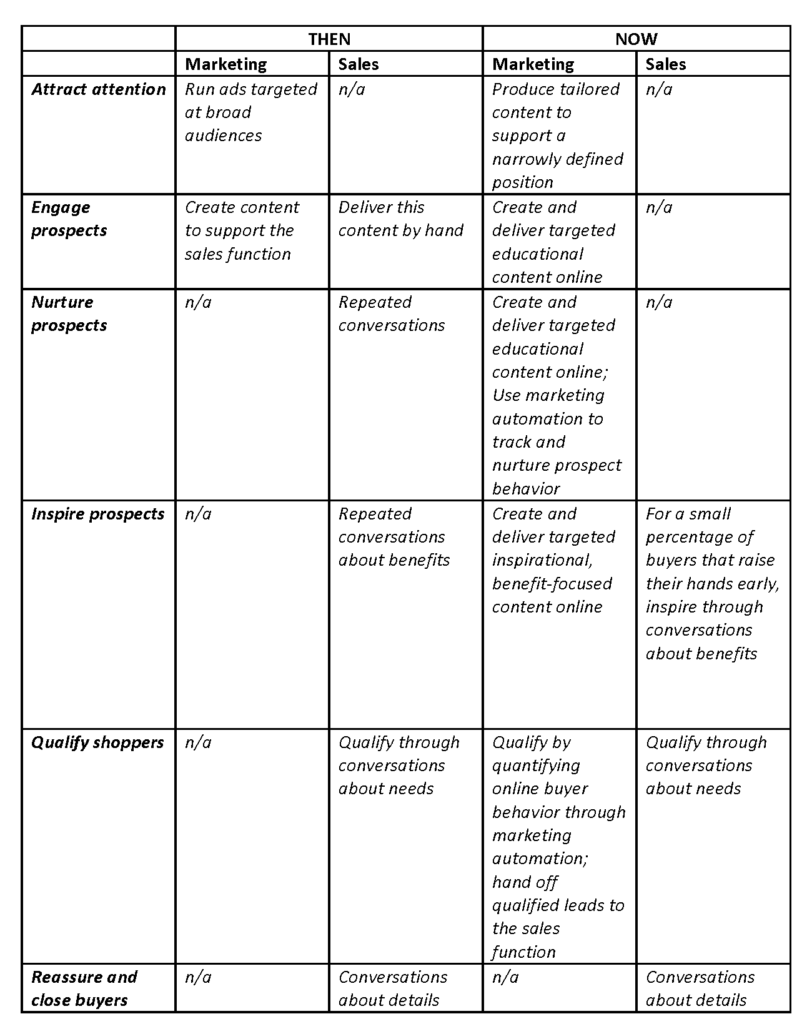Two trends that are reducing the power of the sales function in the life sciences, and what to do about them
By David Chapin
 There are two trends that are changing the importance of the sales role in the life sciences. I’ll outline these trends, which you’ll easily recognize, and then I’ll talk about what this means for life science organizations.
There are two trends that are changing the importance of the sales role in the life sciences. I’ll outline these trends, which you’ll easily recognize, and then I’ll talk about what this means for life science organizations.
TREND 1: Ubiquitous information is reducing the power of the sales department.
It used to be that sellers had all the power in a buy-sell relationship, because they owned all the information. The only way a buyer could learn about a product or service was to ask a salesperson. By controlling the flow of information, the sales function controlled the buyers’ perceptions of the entire solution, including the features and benefits.
But the Internet has turned this on its head: buyers now have much more power than they used to, and in many cases they have more power than the seller. As Dan Pink has pointed out in his book To Sell is Human, the buy-sell relationship used to be characterized as caveat emptor (let the buyer beware), but is now better characterized as caveat venditor, (let the seller beware).
TREND 2: Buyer anonymity is reducing the power of the sales department.
Not only do buyers have access to more information, buyers can now gather this information anonymously. If you pay attention you might see an increase in traffic to your web site as anonymous buyers learn what they need and then disappear back into the anonymity of the Internet, but you can’t see much more than a few very narrow, aggregated statistics. Shoppers don’t have to reveal their identity until they’re ready. And typically, they’re not ready until very late in the buying cycle, after they’ve already made lists of criteria, found possible suppliers, judged which of these suppliers might be able to help them with their needs, started to eliminate some suppliers from consideration, and, in general, asked and answered many of the questions that arise as they traverse most of the buying cycle.
Buyers are going through a majority of the sale process anonymously, which means that by the time they do raise their hand and step out of the anonymity of the Internet, they’ve mostly made up their minds. By this time, it’s very difficult to affect their attitudes, beliefs and behaviors.
So, how can we counteract these trends?
I believe these trends can’t be overcome; you have to live with them, and more than that, figure out how to exploit them. Here’s what I would suggest:
1) Specialize (and clarify what you stand for)
By the end of WWII, all of human knowledge was doubling about every 25 years. Today, different types of knowledge are growing at different rates, but in general, total human knowledge is doubling about every year or so. And the rate is growing exponentially.
To stand out among this rising flood of information, you have to specialize; you must narrow what you stand for, so you can be unique enough to be found. If you don’t narrow your focus, you’ll never be found by those anonymous searchers out there. No one will look on page 127 of the Google results to click on your place in the search results. You’ve got to be on the first page, and the only way to do that is to be tightly focused.
It’s important to understand that specialization only applies to how you want to be found. It doesn’t apply to what you do once you start a conversation with a prospect. You can tailor your conversations in many ways once the conversation begins, but it won’t begin unless you’re approached by someone who is willing to drop their anonymity.
2) Be generous (and share what you know)
To be found by these anonymous buyers who are hunting for information to fuel their buying process, you have to think like a publisher. That is, you need to produce unique, expert content and give it away for free. This is content marketing, and it’s an exchange: unique information is given away in exchange for an increased reputation and increased trust. Exchanging unique information for reputation and trust was actually invented by scientists more than three centuries ago; it’s known as “peer-reviewed publishing.”
Even though scientists invented and then codified this exchange, scientifically based companies are, in general, pretty bad at content marketing. If you want to survive, you’ve got to get good at content marketing, and quickly.
3) Change the relationship between the sales and marketing functions
The sales function in the life sciences used to carry too many responsibilities. They had to find prospects, feed them information, nurture them through the buying process, and then help close the deal.
As buyers go through a majority of the sales process without ever engaging the sales function, companies in the life sciences have to find other ways to fill the needs of these anonymous shoppers. The marketing function must step up to address these needs. If we fail to do so, we’ll be abdicating our responsibility (and wasting a golden opportunity).
The comparison between the marketing and sales functions of the past and the high-performance functions at present can be summarized below:
The sales function will still have power, but that power can’t come from controlling the flow of information to shoppers. Their new source of power comes from helping the shoppers that have raised their hands figure out whether the company’s offering is the best match for their needs. This involves offering inspiration and then reassurance as buyers go through the buying cycle.It is crucial to realign the marketing and sales functions. Marketing should be responsible for attracting, engaging and qualifying a steady stream of leads, enticing them to step out of the anonymous shadows and begin a dialog. Marketing will then be able to turn over truly qualified leads to the sales function.
Welcome to the new century.







